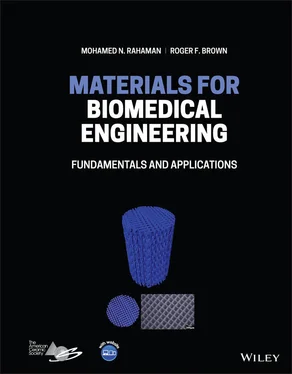Each chapter is replete with data and illustrations to augment the discussion, and concludes with a set of problems and a list of references for further reading. These problems may be suitable for classroom tests and discussions, as well as for reviewing key topics covered in each chapter. Overall, the references have been selected to provide sources of additional information related to specific studies discussed in the chapter and to include seminal publications enlarging upon major topics discussed in the chapter.
We would like to thank the many publishers and authors who have given us permission to reuse their figures and tables in this book. We would also like to express our appreciation to the many students we have taught in our biomaterials and tissue engineering courses over the years and to our students who have contributed to our research and publications. The structure of this book and the body of knowledge incorporated within it have benefitted from their contributions. Finally, we would like to express our gratitude to our wives, Vashanti Rahaman and Peggy Brown, for their support during the lengthy period of preparing this book manuscript.
About the Companion Website
This book is accompanied by a companion website:
www.wiley.com/go/rahaman/biomedicalengineering 
The website includes the following materials:
Figures, Tables and Solutions Manual.
Part I General Introduction
1 Biomaterials – An Introductory Overview
1.1 Introduction
Materials have been used to treat, replace, or augment tissues and organs in the human body since antiquity but their use and degree of sophistication have increased significantly over time, particularly over the last several decades. Advances in materials science, biological sciences, physical sciences, and engineering along with an evolution in medical treatment over the last several decades have led to the creation of biomaterials with more reproducible properties, better performance, and increased functionality. These advances have resulted in a considerable increase in the range of use and the efficacy of biomaterials. Nowadays, millions of lives are being improved or saved by the use of biomaterials in fracture fixation plates, implants for total hip and knee joint replacement, dental implants and restorations, heart valves, vascular grafts and stents, contact and intraocular lenses, skin substitutes, and wound healing materials, for example ( Figure 1.1).

Figure 1.1 Examples of biomaterials in use for medical and dental applications. (a) Fracture fixation plate; (b) implant for total hip replacement; (c) implant for total knee replacement; (d) dental implant; (e) heart valve; (f) vascular graft; (g) intravascular stent; (h) intraocular lens; (i) degradable suture; (j) degradable screw for fracture fixation; (k) degradable polymer microsphere for delivery of therapeutics; (l) functional skin substitute.
The applications of biomaterials are many. Table 1.1provides a list of selected applications and the types of materials used in these applications. Many of the biomaterials used in these applications were selected from durable, chemically inert materials that were available off the shelf, and they were designed to serve, mainly, a mechanical (or physical) function. The last few decades have seen a shift in emphasis in which the biological sciences are playing a role in the design of biomaterials of significance comparable to that of materials science. Biomaterials are now no longer designed to be chemically inert or to just serve a mechanical function. Instead, advances in biological sciences are being used to design biomaterials to regenerate tissues and organs and to direct the response of specific cells and tissues. In doing so, these biomaterials stimulate the body to heal itself. An example is the creation of functional skin substitutes to treat patients with severe burns ( Figure 1.1l).
Table 1.1 Key applications of synthetic materials and modified natural materials in medicine a.
Source: Modified from Ratner (2013).
| Application |
Biomaterial |
Number used per year worldwide (or market in US$) |
| Skeletal system |
| Joint replacement (hip; knee; shoulder) |
Titanium; stainless steel; polyethylene |
2.5 million |
| Bone fixation plates and screws |
Metals; polylactic acid |
1.5 million |
| Spine repair |
Titanium; polyether ether ketone; silicon nitride |
800 000 |
| Bone cement |
Polymethylmethacrylate |
($600 million) |
| Bone defect repair |
Calcium phosphates |
— |
| Artificial tendon or ligament |
Polyester fibers |
— |
| Dental implants |
Titanium |
($4 billion) |
| Cardiovascular system |
| Blood vessel prosthesis |
Dacron; expanded polyethylene |
200 000 |
| Heart valve |
Dacron; carbon; metal; treated natural tissue |
400 000 |
| Pacemaker |
Titanium; polyurethane |
600 000 |
| Implantable defibrillator |
Titanium; polyurethane |
300 000 |
| Stents |
Stainless steel; cobalt–chromium alloy; nickel–titanium alloy |
1.5 million |
| Catheters |
Teflon; silicone; polyurethane |
1 billion ($20 billion) |
| Organs |
| Heart assist devices |
Polyurethane; titanium; stainless steel |
4000 |
| Hemodialysis |
Polysulfone; silicone |
1.8 million patients ($70 billion) |
| Blood oxygenator |
Silicone |
1 million |
| Skin substitute |
Collagen; cadaver skin; nylon; silicone |
($1 billion) |
| Ophthalmologic |
| Contact lens |
Acrylate, methacrylate and silicone polymers |
150 million |
| Intraocular lens |
Acrylate and methacrylate polymers |
7 million |
| Corneal bandage lens |
Hydrogel |
— |
| Glaucoma drain |
Silicone; polypropylene |
($200 million) |
| Other |
| Cochlear prosthesis |
Platinum; platinum–iridium; silicone |
250 000 users |
| Breast implant |
Silicone |
700 000 |
| Hernia mesh |
Silicone; polypropylene; teflon |
200 000 ($4 billion) |
| Sutures |
Polylactic acid; polydioxanone; polypropylene; stainless steel |
($2 billion) |
| Blood bags |
Polyvinyl chloride |
— |
| Ear tubes (Tympanostomy) |
Silicone; teflon |
1.5 million |
| Intrauterine device |
Silicone; copper |
1 million |
aData compiled from many sources – these numbers should be considered rough estimates that are growing with changing markets and new technologies. Where only US numbers are available, world usage is estimated at 2.5 times the US usage.
The importance of biomaterials to society has been increasing significantly in the last several decades, both as an academic field, an area of research to develop new or improved devices, and as an industry ( Figure 1.2). The number of biomedical engineering (or bioengineering) departments in academic institutions has increased rapidly over the last few decades. There are over 75 biomedical engineering (or bioengineering) departments in the United States alone. Biomaterials are an important area of teaching and research in these departments and they are often emphasized in engineering disciplines such as materials science and engineering, chemical engineering, and mechanical engineering.
Читать дальше














